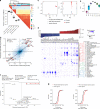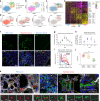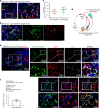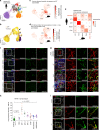Alveolar regeneration through a Krt8+ transitional stem cell state that persists in human lung fibrosis
- PMID: 32678092
- PMCID: PMC7366678
- DOI: 10.1038/s41467-020-17358-3
Alveolar regeneration through a Krt8+ transitional stem cell state that persists in human lung fibrosis
Abstract
The cell type specific sequences of transcriptional programs during lung regeneration have remained elusive. Using time-series single cell RNA-seq of the bleomycin lung injury model, we resolved transcriptional dynamics for 28 cell types. Trajectory modeling together with lineage tracing revealed that airway and alveolar stem cells converge on a unique Krt8 + transitional stem cell state during alveolar regeneration. These cells have squamous morphology, feature p53 and NFkB activation and display transcriptional features of cellular senescence. The Krt8+ state appears in several independent models of lung injury and persists in human lung fibrosis, creating a distinct cell-cell communication network with mesenchyme and macrophages during repair. We generated a model of gene regulatory programs leading to Krt8+ transitional cells and their terminal differentiation to alveolar type-1 cells. We propose that in lung fibrosis, perturbed molecular checkpoints on the way to terminal differentiation can cause aberrant persistence of regenerative intermediate stem cell states.
Conflict of interest statement
The authors declare no competing interests.
Figures










Comment in
-
A transitional stem cell state in the lung.Nat Cell Biol. 2020 Sep;22(9):1025-1026. doi: 10.1038/s41556-020-0561-5. Nat Cell Biol. 2020. PMID: 32778743 No abstract available.
References
-
- Lodyga, M. et al. Cadherin-11-mediated adhesion of macrophages to myofibroblasts establishes a profibrotic niche of active TGF-β. Sci. Signal. 12, eaao3469 (2019). - PubMed
Publication types
MeSH terms
Substances
Grants and funding
LinkOut - more resources
Full Text Sources
Other Literature Sources
Medical
Molecular Biology Databases
Research Materials
Miscellaneous

